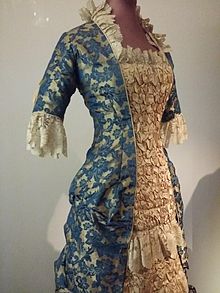

Princess line or princess dress describes a woman's fitted dress or other garment cut in long panels without a horizontal join or separation at the waist.[2][3] Instead of relying on darts to shape the garment, the fit is achieved with long seams (princess seams) and shaped pattern pieces.[4] A rarely used alternative name for the princess line was French-dart-line dress.[5][6]
The princess line is popularly associated with Charles Frederick Worth who first introduced it in the early 1870s.[2][7] It was named in honour of the famously elegant Princess Alexandra.[7][8] By the late 1870s and early 1880s the princess dress was a popular style. It is considered one of the first "bodycon" (body-conscious) fashions due to its extremely closely fitted design, presenting the figure in a natural (or at least, corseted) form undistorted by either crinoline or bustle.[8] Princess-line polonaises were worn over long underskirts.[9] The princess line was also popular for young girls who wore it with a sash or, if slightly older, over a longer underskirt.[10]
The princess line was a staple of dress design and construction throughout the century. In 1951 the couturier Christian Dior presented a princess-line based fashion collection which is sometimes called the "Princess Line", although its official name was Ligne Longue or "Long Line".[11]
The princess line remains a popular style for wedding dresses and a design staple for both day and evening dresses.[2][4] More recently, the design principle has been applied to men's garments, which generally do not have waist seams.[12]